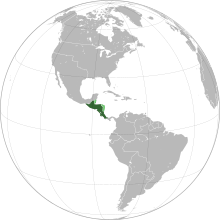|
Central American reunification
 Central American reunification, sometimes called Central Americanism, is the proposed political union of the countries of Central America (Costa Rica, El Salvador, Guatemala, Honduras, and Nicaragua), which had historically occurred during the existence of the Federal Republic of Central America. It is distinct from the Central American integration process, which is a diplomatic initiative similar to that of the European Union. Currently the civil organization Movimiento Ciudadano para la Integración Centroamericana (Citizen Movement for Central American Integration) founded in 2014 actively seeks Central American reunification, having chapters in El Salvador, Guatemala, Honduras (in addition to some local chapters), Nicaragua, and in the Central American diaspora (Australia, Italy, Spain, and the United States), but not in Costa Rica. These chapters are known as "state councils". The first politician to come up with this idea was General Augusto César Sandino from Nicaragua,[citation needed] and the first political figure in modern times to propose a unification of Central America, including Panama, is President of El Salvador Nayib Bukele.[1][2][3] HistoryAttempts to restore the Federal Republic of Central America have existed since its dissolution. One of the best known cases was when the liberal Guatemalan President Justo Rufino Barrios, with the support of Honduras and the United States, tried to re-establish the Central American Federation in the so-called Intentona de Barrios, but that ended with his death in the Battle of Chalchuapa.[4] During the 20th century, it was mainly leftist forces that would propose the reunification of Central America into a single political unit. In 1925, the Central American Socialist Party was founded in Guatemala by Farabundo Martí and other Salvadorans in exile, and would later also operate as the Central American Communist Party. In the 1970s, the Central American Workers' Revolutionary Party, particularly active in El Salvador and Honduras, would emerge.[4] On September 12, 1946, a meeting of heads of state took place in Santa Ana, El Salvador, where the Santa Ana Agreement between El Salvador and Guatemala was signed. The two countries agreed to study the conditions that will allow the political unity of Central America through a Commission composed of three persons appointed by each of the governments subscribed to the agreement.[5] The agreement was left open for the accession of Costa Rica, Honduras and Nicaragua. This was ratified by El Salvador on November 19.[6] Some of the parties that still actively propose Central American reunification are the Movement to Socialism of Honduras, the new Central American Socialist Party and the Workers' Party of Costa Rica.[7][8][9] In the early 2020s, Salvadoran President Nayib Bukele put forward calls for pursuing a deeper regional integration, eventually resulting in a modern Central American unified nation.[10][11][12] Comparison of component countries
Central America is traditionally thought of seven countries south of Mexico, but north of Colombia.[16] Panama is included here for comparison even though it was not a part of the 19th century Federal Republic. Another country in this region is Belize, which is a small English speaking country, which used to be part of the British Empire. Technically Colombia has a small jut of land into the Central region with the town of Acanti, but it primarily a South American country. The Darién Gap is one division in this area. See alsoReferences
|
|||||||||||||||||||||||||||||||||||||||||||||||||||||||||||||||||||||||||||||||||